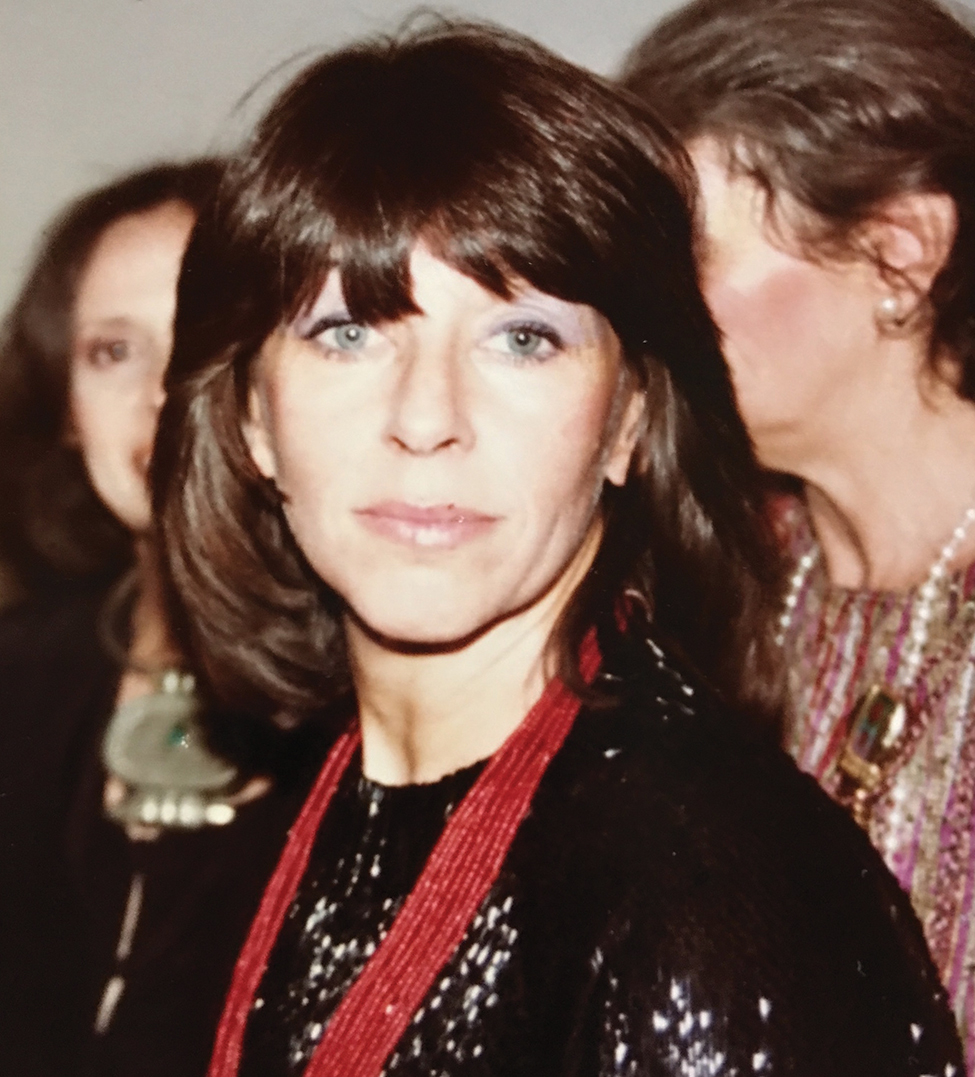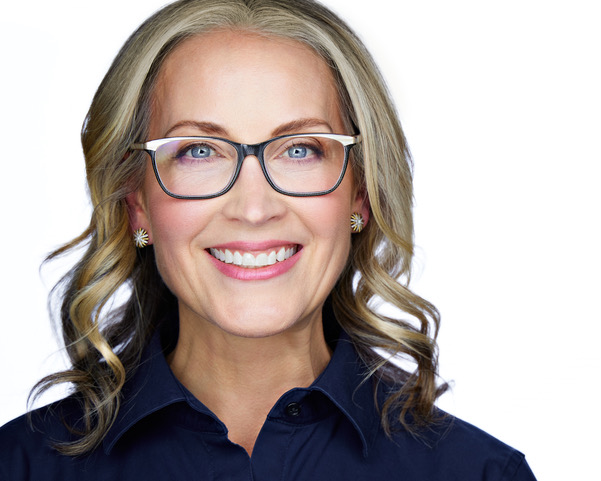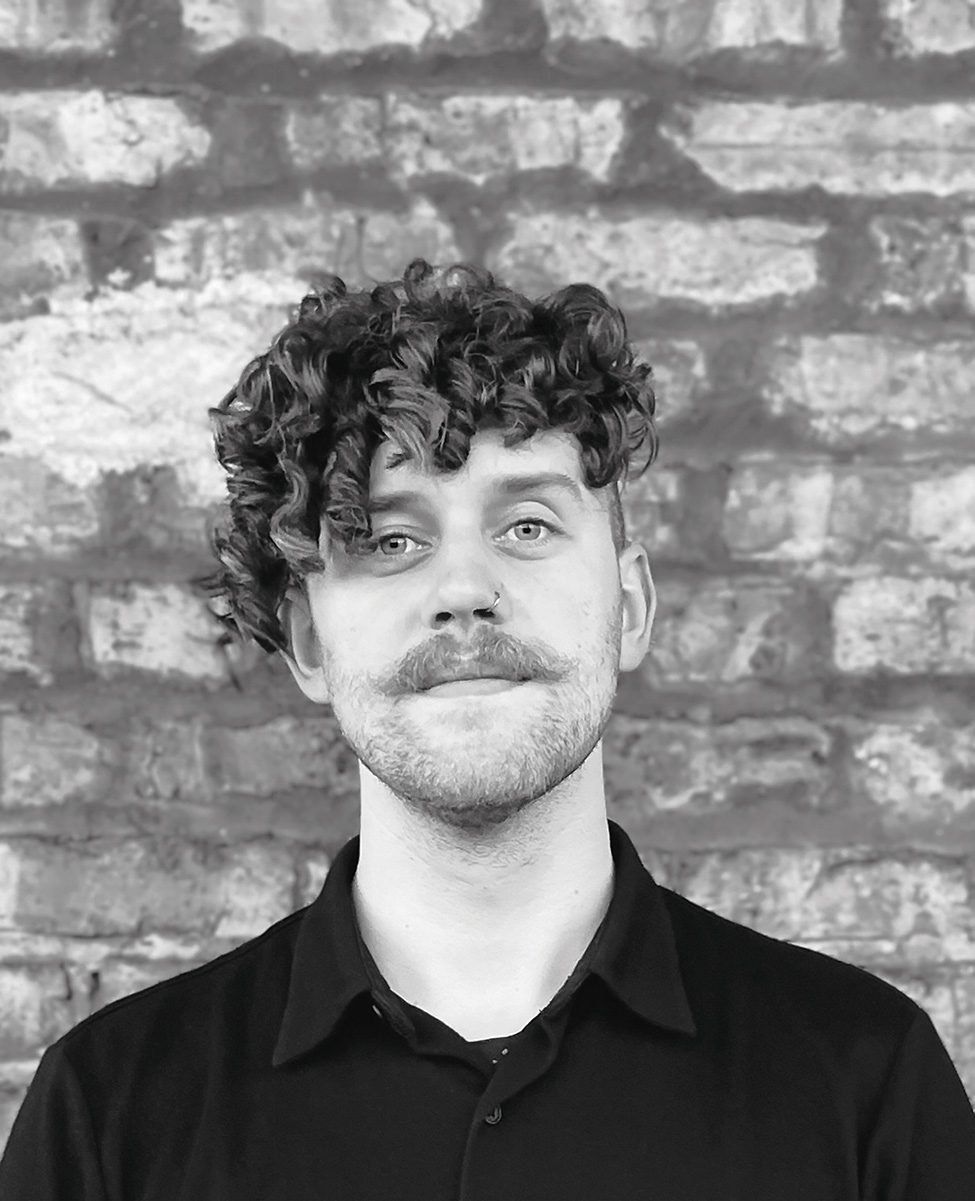Amanda Williams: Her Kind of Blue

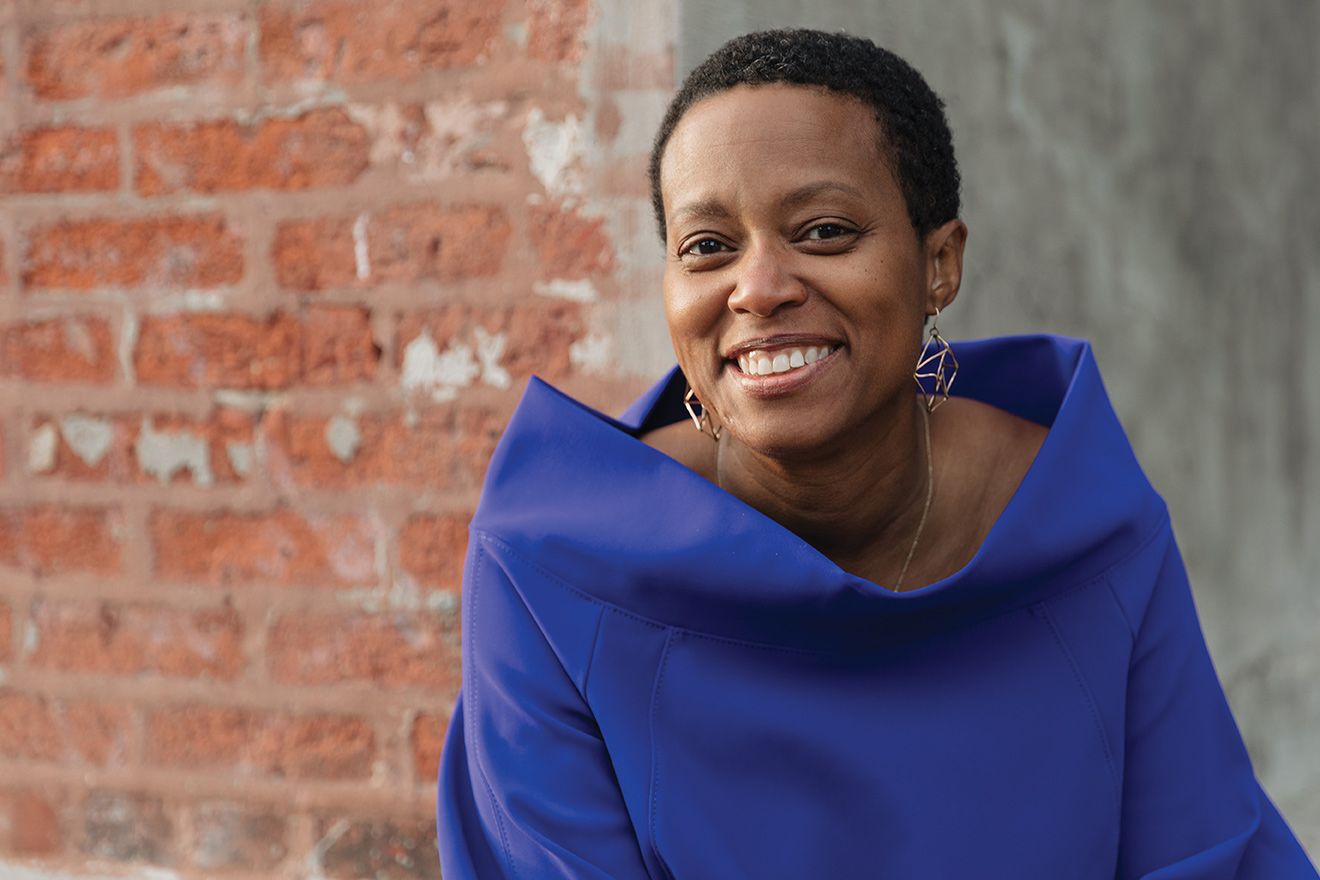
Amanda Williams. Photo courtesy of the John D. and Catherine T. MacAthur Foundation
BY ALISON REILLY
I spoke with Amanda Williams the morning her exhibition Run Together and Look Ugly After the First Rain opened at Casey Kaplan Gallery in New York. Traveling with her family, she quietly slipped out of their hotel room before they woke up to talk with me about her journey—growing up in Chicago, her early career as an architect in the Bay Area, and the path that led her to years of research into Prussian blue pigment. Throughout our conversation, Williams reflected on how her training in architecture continues to shape her artistic practice, her deep love for Chicago, and the ways her work translates complex ideas like discriminatory housing policies into visual form. Williams will be exhibiting with Rhona Hoffman Gallery at EXPO CHICAGO from April 24-27.
CGN: Did you grow up making art?
Amanda Williams: Yeah, I did. All of us grow up making art, and it’s the stage when we stop thinking we’re artists that’s interesting to me. I think everyone is an artist initially, and then we get all these cues from family or society that we’re not artists. I grew up making art from an early age and felt like that was a natural format for me.
CGN: What was your experience like growing up in Chicago?
AW: Oh, it was great. We had a great neighborhood, great families. Summers stand out, but in general, there were lots of kids the same age playing and making up games and super active, whether stick ball or jacks or hopscotch. There was always something we were inventing or plotting, some kind of idea we were exploring, like planting seeds from our apples. I had a really great experience. I have one brother who’s six years younger, so despite the age we were very close and had a lot of friends in the neighborhood. We went to a school across town that was really wonderful and gave us a completely different set of perspectives and friends and so forth.
CGN: How has your relationship to this city changed?
AW: I don’t think my relationship to the city has changed. I’ve always been in love with the city. My passions and my desire to care for it and make it better have always been there, but the sophistication with which I can express that has changed. A lot of people say they don’t like Chicago anymore. They say it’s not what it was. There’s definitely elements that I can understand. But in a lot of ways for a lot of people, the city has always had its limitations and its inequities. It’s not that those things haven’t been impactful in shaping the work that I do, but it’s never been a reason why I don’t think the city is great. My through line is that I really love and believe in the city.
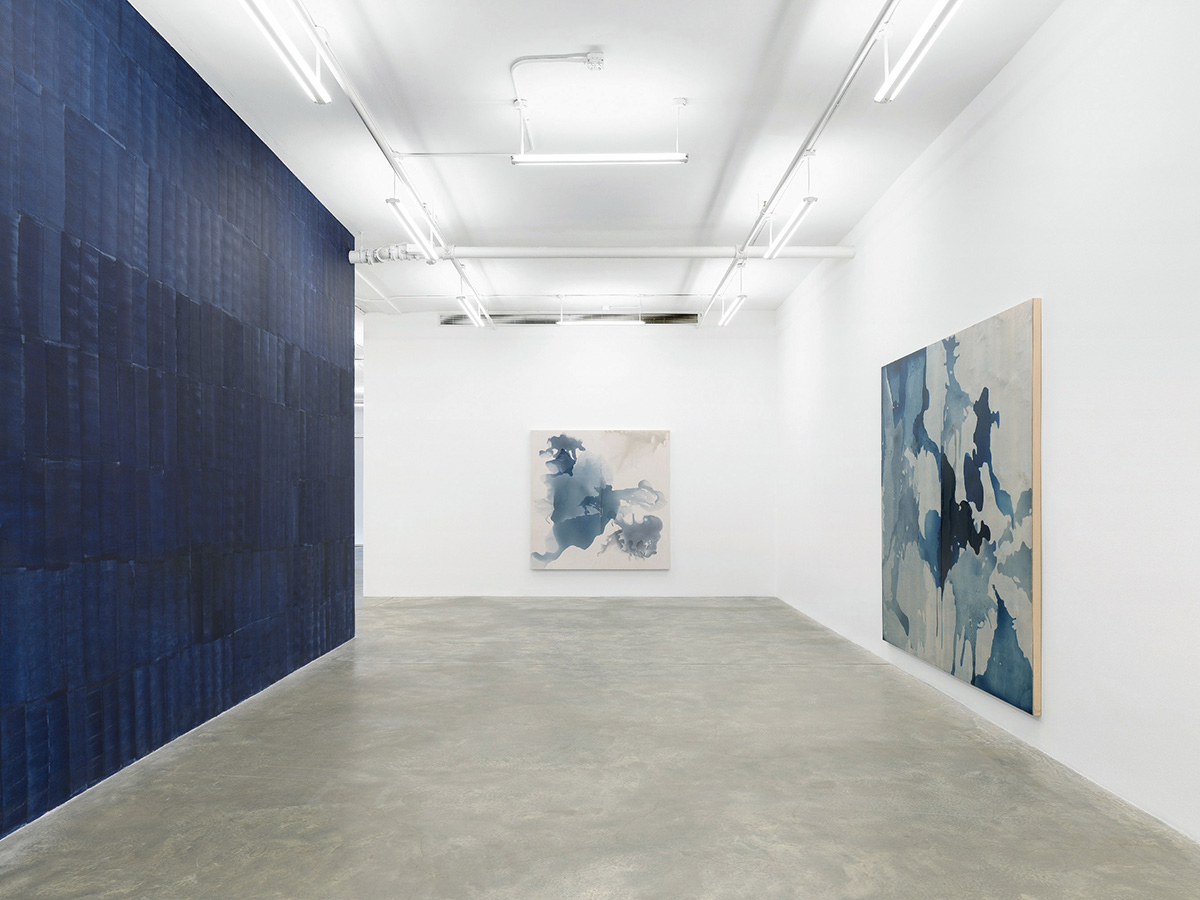
Installation view: Amanda Williams: Run Together and Look Ugly After the First Rain, Casey Kaplan, New York, February 28 - April 26, 2025. Photo: Dan Bradica Studio
CGN: When did you know that you wanted to be an architect and an artist?
AW: As long as I can remember, I knew that would be my orbit. The drive to go into architecture initially was fueled by nervous parents who couldn’t really see a runway for what life as an artist might be, especially for black people in the seventies to imagine that as a viable career. My parents, well-meaning, but naively thought that, well, she’s really good at drawing, and she’s really smart, so that sounds like an architect. Architecture is stable. Growing up in Chicago, you know, somebody joked architecture’s like the fifth sport. In many ways, you wonder why everyone doesn’t want to be an architect in Chicago, because we have such an amazing cross-section of both historic skyscrapers and the Burnham Plan. I would also argue that neighborhoods and what I experienced growing up had an equal influence. But for as long as I can remember, I said I would be an architect.
It drove a lot of my thinking until I got to college at Cornell University. It was a really fantastic experience. There were lots of other Chicagoans there and lots of folks that came from very similar experiences. I didn’t realize it until hindsight, but it was a really special time to be at Cornell in architecture, in particular.
CGN: Did you stay in New York then or come back to Chicago?
AW: I actually graduated and moved immediately to the Bay Area. When I graduated, the economy was very different than right now for the job landscape. There was an abundance of enthusiasm and projects and work. The Bay Area was an epicenter of the dotcom boom–the Silicon Valley boom was in full swing. That meant a lot of opportunities, a lot of jobs, and very creative, ambitious thinking around technology and enterprise. It was a wonderful time to be there. I graduated and had a job immediately, as did my classmates. That transition looks nothing like what I see young people experiencing now.
I worked for about six and a half years as an architect in two firms, McCall Design Group, and then SMWM–Simon Martin-Vegue Winkelstein Moris. The founders and principals of both firms played instrumental roles as mentors, informally, and then helped me make the professional decision to transition from architecture to take this huge leap into art full time. Mike McCall and Cathy Simon, principals respectively of McCall Design Group and SMWM, were huge cheerleaders and thought partners.
CGN: What kinds of projects were you working on?
AW: At McCall Design Group, they did a lot of retail work, which involves very fast-paced projects where you are essentially upholding a style guide or a standard that a company has created for themselves. It was exciting and allowed me as a recent graduate and junior architect the ability to see the entire project all the way through, very quickly. At SMWM, they did a lot of civic work, and I was part of this incredible team, probably 30 people, working on the reimagining and refurbishment of the San Francisco Ferry Building. Chicago has a pier, but not every city has that kind of architecture. Then to be involved in a moment where the building was gaining a new life, and we were mining the history of its old life. I was happy to be riding on the coattails of fantastic leaders that really helped me see the process.
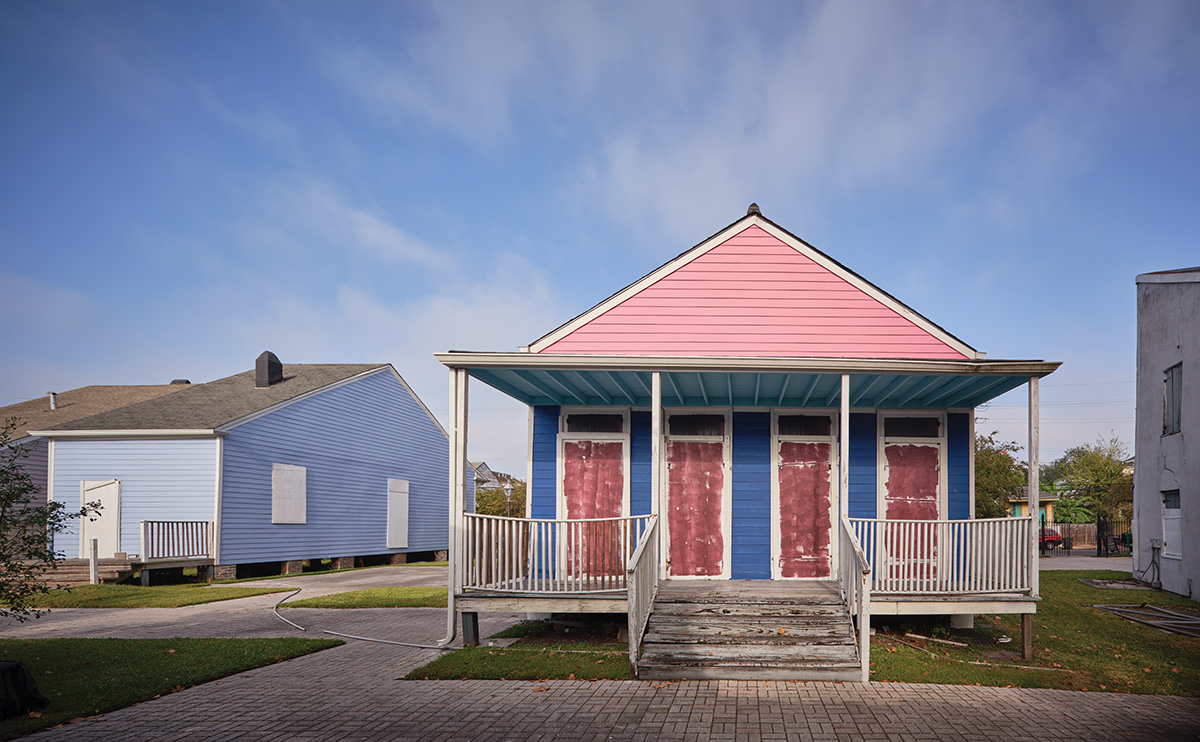
Amanda Williams, In Her Rich Deposits of (Blue), 2024, New Orleans African American Museum for the Prospect.6 Triennial. Courtesy of Amanda Williams LLC and Tom Harris Photography.
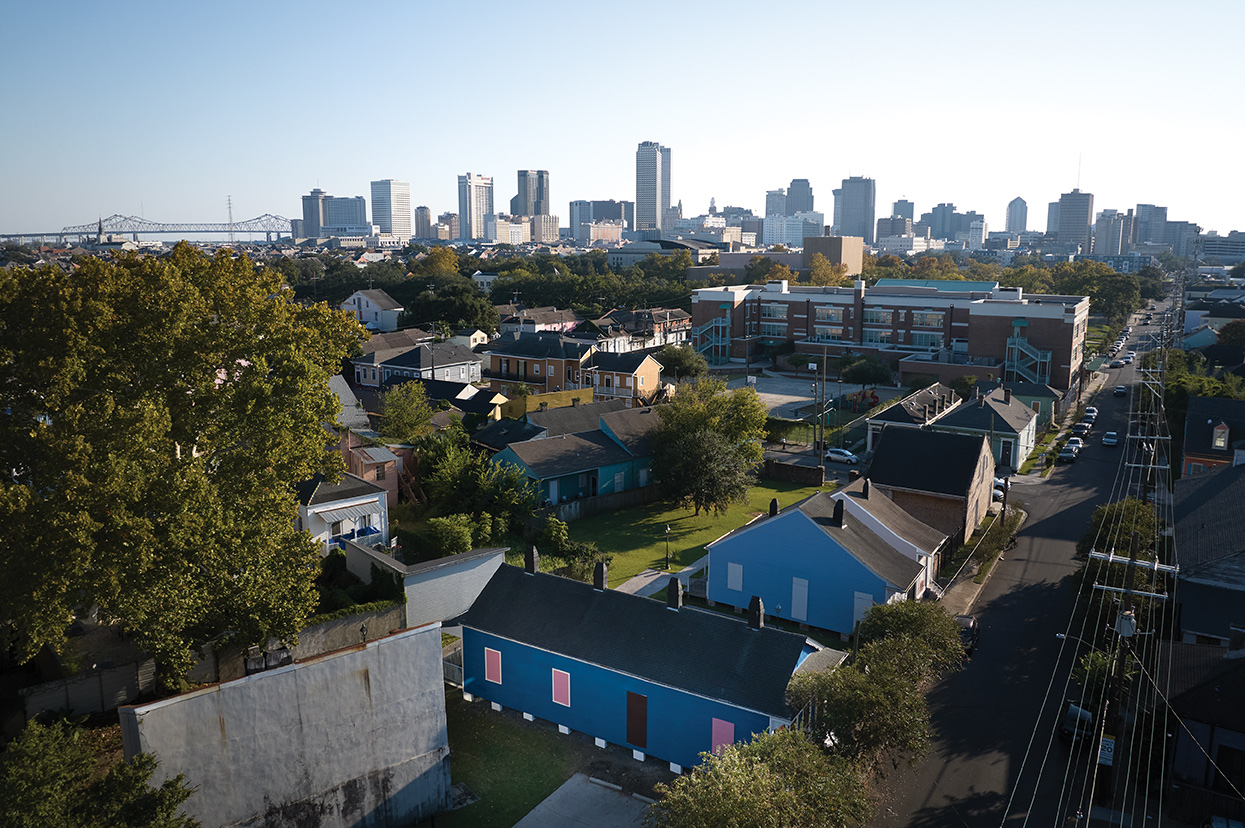
Amanda Williams, In Her Rich Deposits of (Blue), 2024, New Orleans African American Museum for the Prospect.6 Triennial. Courtesy of Amanda Williams LLC and Tom Harris Photography.
CGN: How has your training as an architect influenced your work now?
AW: Being an architect was absolutely amazing and fun. I think it did what I imagined it was going to do. What I, in hindsight, understand is that I’ve always been interested in space. Architecture is a part of that, but spatial experiences, spatial practices, the way people navigate space, the way culture and power influence the way people can move through space and what they get to do in those spaces. That’s really more intriguing to me and really what drives a lot of the way I think about public art and installations and to some degree even the studio based two-dimensional paintings and other media, works on paper, photography and so forth. But architectural education is such an amazing training, because it really is about teaching you how to think a certain way and to problem solve creatively.
It’s also been so central to the way that I imagine projects, either ones that are commissioned or I’m invited to participate in, like Prospect New Orleans or Venice Biennale, but also projects I generate myself, like Redefining Redlining. I’m always trying to think about making that translation of a complex idea that you can understand in words, but what would it mean to expand that so you’re seeing a symbol or a translation of it in another medium? You understand racism, you understand segregation, but how do you translate segregation into art? How do you translate racist housing practices into art? Those processes take longer for me to come up with strategies, but it is definitely impacted and fueled by an ability to think creatively through this architectural training that I had. I might not be making buildings in the traditional sense as an architect, but I very much still carry the identity of architect, because a lot of the ways that I have to go about imagining and executing projects feels very similar.
“I come to every project with color as the foundation. I’m either thinking about a specific palette that reminds me of something I want to talk about, like the red for Redlining and using tulips as the source material or Candy Lady Black and thinking about these saturated colors of candies that I would enjoy growing up and the extended significance of the candy lady as a kind of grandmother figure in the neighborhood giving these sweet confections.”
- Amanda Williams
CGN: I read about your research into George Washington Carver’s blue and your collaboration with Tuskegee University and University of Chicago to reproduce the pigment and then paint an arts building at Xavier University and a shotgun style house at the New Orleans African American Museum. What did you learn as part of that process and why was it important for you to continue Carver’s work?
AW: I come to every project with color as the foundation. I’m either thinking about a specific palette that reminds me of something I want to talk about, like the red for Redlining and using tulips as the source material, or with CandyLadyBlack, thinking about these saturated colors of candies that I would enjoy growing up–and the extended significance of the candy lady as a kind of grandmother figure in the neighborhood giving these sweet confections.
It wasn’t like I started with George Washington Carver–it was that I stumbled upon this patent for the color blue, and he happened to be the person that had done it. I thought it was strange that you’d have a patent for a color, because we imagine that color belongs to everybody and that it’s just always been there. We don’t really think about the origins of color as a material and so that seemed very intriguing to me. When I learned that it was Carver who had patented it, I thought, “Is this the same Carver, the peanut Carver? This guy has three patents and they’re not for sweet potatoes or peanuts or all the things that he’s known for? Why?”
There was research done at Tuskegee, and then simultaneously working with chemistry students at the University of Chicago, to try to get at it from an empirical standpoint but then also this historical component to piece together parts of the story that may not be obvious. Historically, this is 1927. At this time most black people are trying to stay alive. This is very similar to the moment we find ourselves in now. After Reconstruction, a period called Redemption occurs where white people in power didn’t like that black people had figured out a way to start to integrate themselves into society, so there was a huge pushback. This is the moment we find ourselves seeing Carver own a color, essentially. The patent is for a method to make an existing color, Prussian blue. Prussian blue had been accidentally discovered well before that in Europe in the early 1700s. The color’s not new, the synthetic making of the color’s not new, but his ability to understand that there was the source material of the clay that was in abundance on Tuskegee’s campus could be used as a substitute. I’m reducing it a lot but essentially, iron within the red clay that’s in the soil in Alabama, North Carolina, and many parts of the South, could be used as source material.
That seemed very powerful when you think about ownership and identity and then tying that to some kind of financial value and autonomy. This was the opportunity potentially to use the sales of a synthetic paint that Carver could make from the pigment to fund the work that the university was doing. That was the brainchild of Booker T. Washington who was the president and founder of Tuskegee. He was always enterprising and quick to think about things like this. Carver and Washington did try to start a paint company, but it did not succeed. More research is needed, but I suspect that good old-fashioned racism is going to be at the top of the list of factors that made it quite difficult. Carver was an artist as well, and so the more I dug into the biography, the more intrigued and interested I got in him as such a multifaceted person.
At the same time, I was retracing those chemistry steps to see what it might mean to try to follow the recipe of the patent to make the pigment. That process took about a year, and then from there I was able to find a partner in a New-York based company that has facilities in Germany, called Kremer Pigments. The students at University of Chicago were able to make the pigment in very small volumes, and Kremer took the recipe and further refined it and made it at a larger volume for me, so that I could make paint from the pigment.
That led to applications of that pigment with [Prospect] New Orleans being one and then the show at Casey Kaplan Gallery is the culmination of more traditional paintings on canvas, abstractions. I’m debuting 20 paintings and 10 collages that all use this pigment in some form. There’s watercolors, casein, and distemper. These are the traditional media that Carver likely would have used in his own artwork and in painting structures in the Tuskegee area.
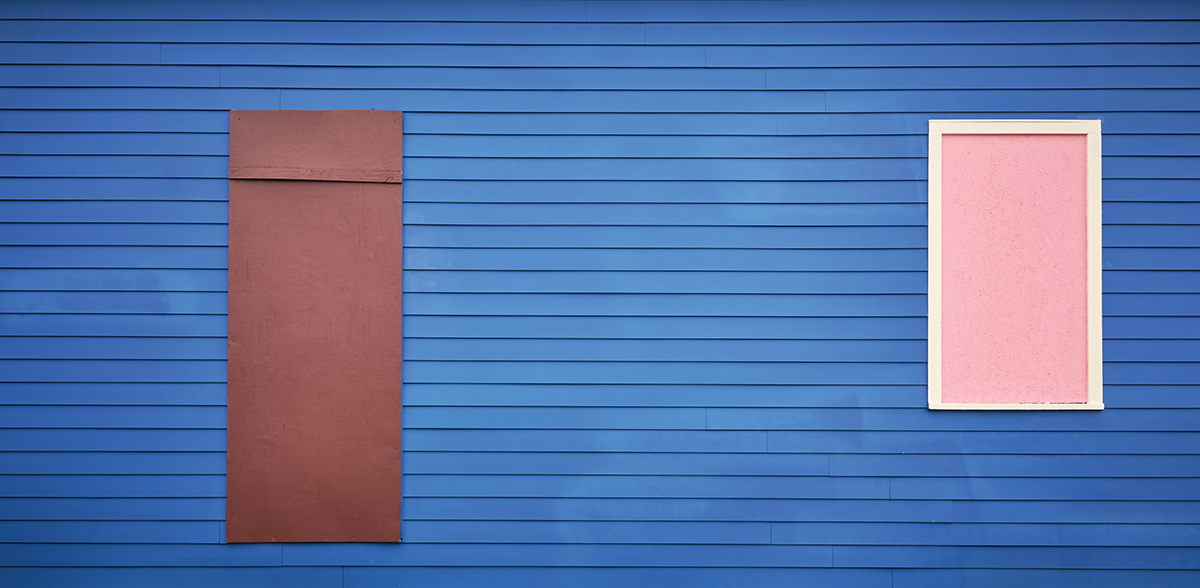
Amanda Williams, In Her Rich Deposits of (Blue), 2024, New Orleans African American Museum for the Prospect.6 Triennial. Courtesy of Amanda Williams LLC and Tom Harris Photography.
CGN: Congratulations on your show. That blue is so powerful, so I’m excited to see it translated into your work.
AW: Yeah, it’s amazing because it behaves very differently. These media behave very differently than oil, which is what I paint with most of the time. When you’re asking about learning, I’ve described a lot of the research that had to go into understanding the elements, but the learning in terms of an art practice or an art form was very driven by having to try to start to master new painting media. Making things from scratch versus just going to Blick and picking out the tubes of color. It’s not a lost art, a lot of people still do it, but the mixing of your own colors even from pre-mixed base colors, I took a certain pride in that I always make my black, and I always make my palettes, but it’s from a pre-bought tube of something else, so to go one step back was not a party trick or trying to show off. It really was like, “Oh, okay, wow we did all this just to get this pigment, but wait a minute, pigment, it’s not paint. How do we do that? We have to mull it and grind it, then what do we do?”
There was a lot of technical learning but also just letting the material be what it is. Each of these media behave differently–they’re like personalities–oil, watercolor, acrylic, casein, tempera, all of those behave very differently. You really have to allow the medium to be what it wants to be. That’s also a beautiful metaphor or signifier, that the best results come when you let people be who they can be.
CGN: What other projects do you have coming up?
AW: The number one project should be rest, so I’m going to try to do that. I haven’t been successful with that yet, but I’ve been going hard and long and strong for a long time. But I do have some public projects that will be coming up in Chicago. One is an intervention upon the George Washington statue that sits at the northwest corner of Washington Park. That’s part of a multi-pronged grant that former DCASE commissioner Erin Harkey secured for the city for eight or nine different public projects including the Torture Justice Memorial and some projects by Brendan Fernandes. I’m one of the artists. A Long Walk Home is doing a tribute to Rekia Boyd. A beautiful cross section of projects that are both new and then also ones that support retelling.
I’m hoping to reframe the way we think about George Washington Carver, literally with a frame. The project is called The Other Washingtons, and it looks at the biographies and the significance in a neighborhood of other people with the last name Washington that might be more important or impactful to the lives of the residents of Washington Park in Bronzeville. Whether that be Denzel or Harold or Dinah or Candice Washington, who’s an amazing educator on the South Side, who should go down in history, but maybe won’t have the largesse of George Washington. What does it mean to bring Candice’s biography and put it in conversation with George Washington? Her presence is going to make more of an impact in that community with the work that she does with young people than their understanding of a largely embellished biography of George Washington. It’s not erasing him or erasing the legacy of what it means to monumentalize individuals, but what does it mean when that’s applied across the board, whether you’re famous or not, whether you are white and male or not? That project is in the works and will probably come in the fall or early in 2026.
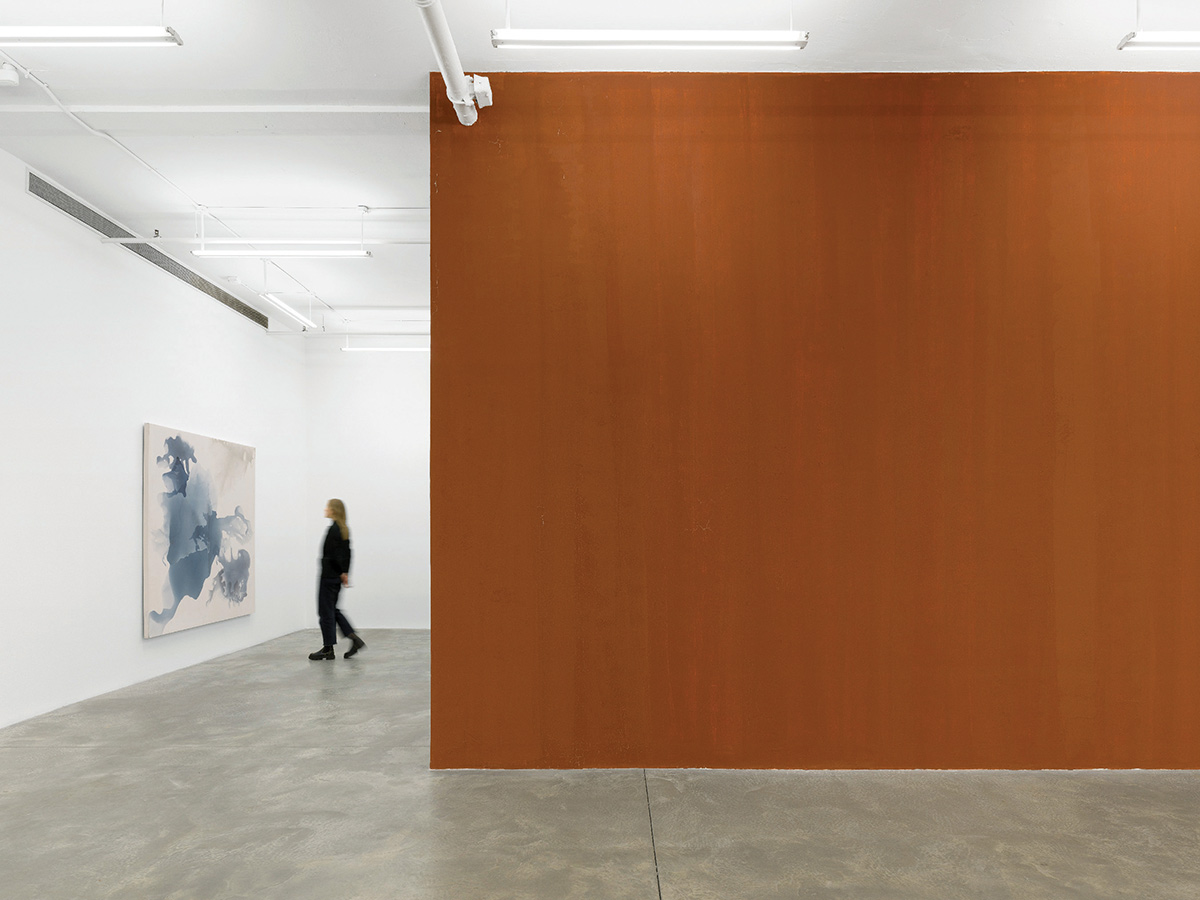
Installation view: Amanda Williams: Run Together and Look Ugly After the First Rain, Casey Kaplan, New York, February 28 - April 26, 2025. Photo: Dan Bradica Studio
CGN: Earlier you mentioned the moment that we’re in right now. Has your own artistic approach shifted at all as a result of Donald Trump’s election and his administration’s attempts to censor Black history and dismantle programs meant to fight systemic inequity? How are you thinking about your work in light of the current political climate?
AW: No, it hasn’t shifted–not one bit. I was saying to somebody recently, there’s never been a moment where the majority of Black Americans have felt like they’re not fighting for their lives. There are small ebbs and flows of life seeming to get better or seeing the result of that commitment to be steadfast and fight. Anybody that’s surprised or not understanding how we got to this moment, maybe either isn’t old enough to have already cycled through other moments that were really bad in terms of Black history, and it’s not just Black history, it’s American history. America likes to glom onto Blackness, which is ironic, right? Because the atrocities have nothing to do with the victim, it has to do with the perpetrator. The responsibility always seems to fall on the person being oppressed.
These are the things I’ve always been talking about. They feel amplified now because the temperature has been turned up on the people that don’t want that to happen. When that temperature got turned up, they turned their temperature up. I’m glad I’m a parent, because I can observe all this behavior as I did when I had toddlers. When it’s time to go to bed, and you’re really sleepy and you know you’re losing the battle, you throw a tantrum. You run, you knock things over, you do whatever you can to distract from the fact that the inevitability is coming: you’re going to fall asleep. I see it in that same way, where we’re in this last surge of fighting against the reality, which is that straight, white men are not the majority in this country, and they’re going to fight to the death to maintain that power. While it’s disconcerting–it’s distracting, it’s draining, it’s all of those things–the people who have had to fight that at different degrees their entire lives are not surprised. This is not to at all minimize being scared, the violence with which these things that we assumed were pillars are being ripped. But they are all constructs. We’ve just gone along with it because many of these things seem like inalienable rights.
My strategy is to stay the course, doing what I’m doing. Obviously, as young people say, have your head on swivel. I’m not naive to imminent danger, but I don’t give oxygen to fire; I have to be water. Not to sound hokey, but we have to be the thing that remains the constant. The more of us who know that, we can link together and help those of us who are maybe experiencing something so heinous for the first time.
These are active stories from my childhood. My father was from Memphis, my mother is from Alabama. My day-to-day experience in Auburn Gresham was not hoses and dogs, and being turned away at lunch counters, but those are active stories. That’s not past-tense. My father picked cotton. I went to private school–imagine the leap! He was college-educated as well, but he existed in a time where that was a job.
Technology has pressed the fast forward as well as the amnesia button, and so right now it seems that much more traumatic. The strategies for not being harmed by that trauma are not present, because people have gotten comfortable–they either have never had to experience it, or they are a generation removed from when that felt like an active threat. We’re hopeful that people have resilience enough to push through, but the majority of people who are feeling overwhelmed is a result of not ever having to think about this.
AMANDA WILLIAMS: RUN TOGETHER AND LOOK UGLY AFTER THE FIRST RAIN is on view at Casey Kaplan Gallery in New York thru APRIL 26, 2025 at Caseykaplangallery.com
View more information and works at:
#
This article appears in the Spring/Summer 2025 issue of CGN. Click here to subscribe and receive the print edition in early April. Subscriptions help support independent print media and Chicago's art community.
